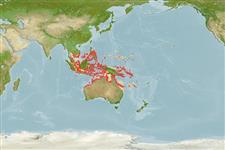>
Perciformes/Uranoscopoidei (Sand dwellers) >
Pinguipedidae (Sandperches)
Etymology: Parapercis: Greek, para = the side of + Greek, perke = perch (Ref. 45335); lineopunctata: From the Latin words 'linea', line, and 'punctum', dot, in reference to the prevalence of dotted lines on the body..
More on author: Randall.
Environment: milieu / climate zone / depth range / distribution range
ນິເວດວິທະຍາ
ສັດທະເລ ກ່ຽວກັນຫີນ; ບໍ່ມີການເຄື່ອນຍ້າຍ (Ref. 57562); ລະດັບຄວາມເລິກ 3 - 35 m (Ref. 90102). Tropical; 15°N - 25°S, 100°E - 165°E (Ref. 57562)
Western Pacific: Sumatra, Sulawesi, Philippines, to Great Barrier Reef, Solomon Islands, Lord Howe Island.
ຂະໜາດ / ນ້ຳໜັກ / Age
Maturity: Lm ? range ? - ? cm
Max length : 7.4 cm SL ຕົວຜູ້/ບໍ່ມີເພດ; (Ref. 57562); 7.6 cm SL (female)
Short description
ສະລີລະວິທະຍາ | ການວັດແທກຮູບຮ່າງລັກສະນະພາຍນອກຂອງດິນ,ສັດ,ປາ…
ຄີ (ໜາມ)ແຂງຢູ່ຫຼັງປາ (ທັງໝົດ): 5; ຄີຫຼັງຂອງປາ (ຄີອ່ອນ) (ທັງໝົດ): 20-21; ຄີ(ໜາມ) ແຂງຢູ່ຄີກົ້ນປາ
ກຸ່ມປາກະດູກແຂງ
ຄວາມຖີ່ຂອງກຸ່ມຖ່າຍທອດພັນ
ປາທີ່ມີການເຄື່ອນຍ້າຍຈາກທະເລໄປຫານ້ຳຈືດ ແລະນ້ຳຈືດຫາທະເລ
ປາທີ່ມີການເຄື່ອນຍ້າຍຈາກທະເລແລະໄປໄຂ່ຢູ່ນ້ຳຈືດ
ຄີກົ້ນຂອງປາ
ສັດທີ່ມີກະດູກສັນຫັຼງ
ການຖ່າຍທອດທາງກຳມະພັນຈາກພໍ່ແມ່ຫາລູກ 1; ຄີກົ້ນຂອງປາ: 16 - 18. This species is distinguished by the following characters: D V,21; A I,17; 14-16 (rarely 14 or 16) pectoral rays; 45-51 lateral-line scales; about 4 predorsal scales; ctenoid scales on cheek, in 5-6 horizontal rows; 3-4 + 8-10 gill rakers; front of lower jaw with 8 canine teeth; with palatine teeth; upper edge of subopercle with a prominent sharp spine; middle dorsal spine longest; membrane from last dorsal spine joined to base of first soft ray; body pale greenish to pale yellow dorsally, white below, with a series of 5 broad double dark bars on back, smaller posteriorly; lower part of body with a series of 9 bars, the top of each with a short blackish dash; a black line runs from the front of upper lip to eye, sometimes with 1-3 iridescent pale blue lines on snout and cheek below eye; 2 rows of black dots from behind eye along back to about middle of body, 1 row just above and the other just below lateral line; rear of cheek and lower opercle with black dots, often continuing in irregular rows anteriorly on body; first dorsal fin with a large dusky to dark brown spot at base, and often a submarginal dark brown or red line (or combined dark brown and red) (Ref. 57562).
The species is generally found in calm environments on sand or rubble near reefs. A protogynous hermaphrodite (Ref. 057562). Minimum depth of 3 m reported from Ref. 57562.
Life cycle and mating behavior
ການຈະເລີນເຕັມໄວ | ການສືບພັນ | ການວາງໄຂ່ | ໄຂ່ | ຄວາມດົກຂອງໄຂ່ປາ | ຕົວອ່ອນ
Randall, J.E., 2003. Review of the sandperches of the Parapercis cylindrica complex (Perciformes: Pinguipedidae), with description of two new species from the western Pacific. Bishop Museum Occasional Papers (72):1-19. (Ref. 57562)
IUCN Red List Status (Ref. 130435)
Threat to humans
Harmless
Human uses
ຂໍ້ມູນຕື່ມອີກ
ຊື່ສາມັນຄຳສັບຄ້າຍຄືກັນການເຜົາໃໝ້ພະລັງງານໂດຍປ່ຽນທາດອາຫານໃນຮ່າງກາຍໃຫ້ກາຍເປັນຊີ້ນແລະໜັງຜູ້ລ້າການສຶກສາຜົນກະທົບຂອງສານຜິດທີ່ມີຜົນກະທົບຕໍ່ລະບົບນິເວດການສືບພັນການຈະເລີນເຕັມໄວການວາງໄຂ່ການສັງລວມການວາງໄຂ່ຄວາມດົກຂອງໄຂ່ປາໄຂ່Egg development
Age/Sizeການເຕີບໃຫຍ່Length-weightLength-lengthLength-frequenciesການວັດແທກຮູບຮ່າງລັກສະນະພາຍນອກຂອງດິນ,ສັດ,ປາ…ສະລີລະວິທະຍາຕົວອ່ອນການປ່ຽນແປງຂອງຕົວອ່ອນການທົດແທນທີ່ຄວາມອຸດົມສົມບູນBRUVS
ເອກະສານອ້າງອີງການລ້ຽງສັດນ້ຳຂໍ້ມູນການລ້ຽງສັດນ້ຳສາຍພັນກຳມະພັນElectrophoresesການຖ່າຍທອດທາງກຳມະພັນຈາກພໍ່ແມ່ຫາລູກພະຍາດການປຸງແຕ່ງNutrientsMass conversion
ຜູ້ຮ່ວມມືຮູບStamps, Coins Misc.ສຽງຫອຍມີພິດຊະນິດນຶ່ງທີ່ອາໄສໃນທະເລຄວາມໄວປະເພດການລອຍເນື້ອທີ່ເຫືອກOtolithsສະໝອງວິໄສທັດ
ເຄື່ອງມື
Special reports
Download XML
ແຫຼ່ງອີນເຕີເນັດ
Estimates based on models
Preferred temperature (Ref.
123201): 26.7 - 29, mean 28.2 °C (based on 534 cells).
Phylogenetic diversity index (Ref.
82804): PD
50 = 0.5000 [Uniqueness, from 0.5 = low to 2.0 = high].
Bayesian length-weight: a=0.00692 (0.00311 - 0.01538), b=3.06 (2.88 - 3.24), in cm total length, based on LWR estimates for this Genus-body shape (Ref.
93245).
ຊັ້ນເຂດຮ້ອນ (Ref.
69278): 3.4 ±0.4 se; based on size and trophs of closest relatives
ຄວາມຢືດຢຸ່ນ (Ref.
120179): ສູງ, ປະຊາກອນຕຳ່ສຸດທີ່ໃຊ້ເວລາສອງໜ້ອຍກວ່າ 15 ເດືອນ (Preliminary K or Fecundity.).
Fishing Vulnerability (Ref.
59153): Low vulnerability (10 of 100).
Nutrients (Ref.
124155): Calcium = 182 [93, 310] mg/100g; Iron = 0.932 [0.539, 1.594] mg/100g; Protein = 18 [16, 20] %; Omega3 = 0.113 [0.062, 0.207] g/100g; Selenium = 28.2 [12.7, 61.8] μg/100g; VitaminA = 123 [39, 374] μg/100g; Zinc = 2.14 [1.38, 3.12] mg/100g (wet weight);
